Malted Pumpkin Custard
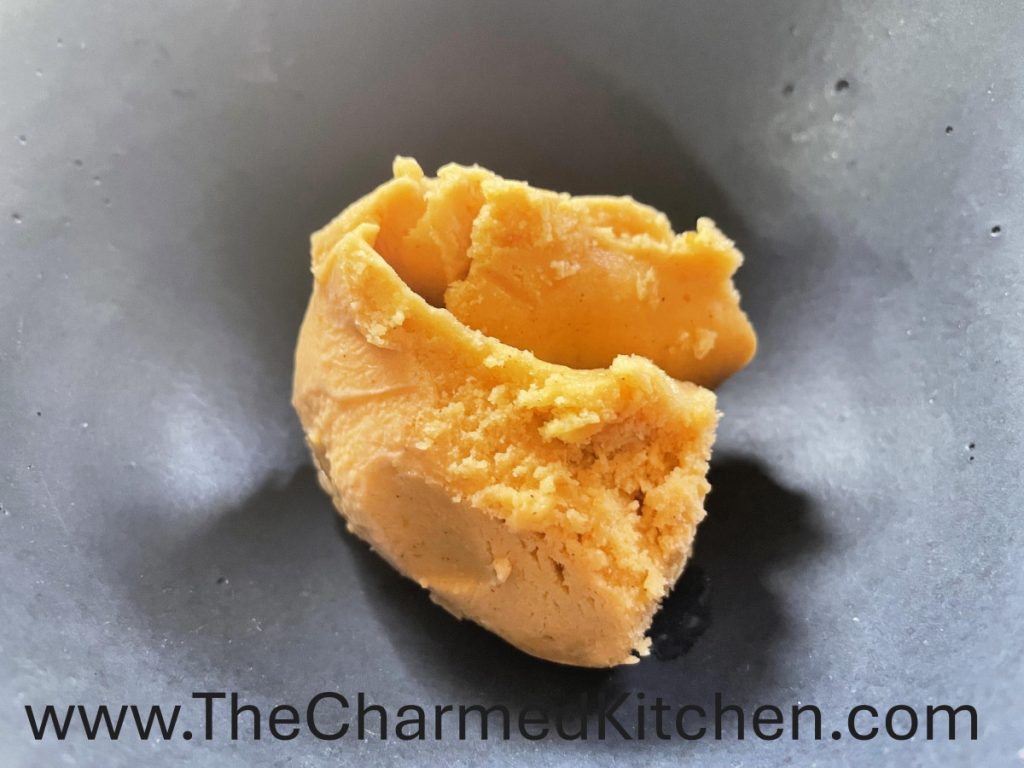
This custard came about because my friend Joe brought me some malted ice cream one day. We started talking about malt. We wondered what malt was exactly and why did we like it so much.
Malt is a sprouted grain, usually barley, that is dried after it has sprouted. It had a unique flavor that is used in baking, beer making and desserts to name a few. For this recipe I used malted milk powder, which also contains some sugar and dairy.
You can also buy diastatic malt, which I use in bread baking and malt syrup. Let’s not forget how good malt vinegar is on fries.
So back to this recipe. I decided to make a custard base, using whole eggs. I like the texture of the final product. Plus, since I was using a fair amount of pumpkin, I liked the eggs for a little added fat in the recipe. The first time I made it, a couple of friends were over. I put it in the ice cream maker while we were having dinner. Both of them loved it. I knew I had to make it again.
I might have used more than a cup of pumpkin with the latest batch. I know it was at least a cup. It doesn’t matter a whole lot in the scheme of things, but the pumpkin flavor was more pronounced in the batch I made last night. I was fine with that.
I used pumpkin this time, but you can just as easily use other winter squash like butternut or Hubbard.
So here is the recipe. I think you’ll like it as much as we did.
Malted Pumpkin Custard
4 eggs
1 c. half and half
¾ c. sugar
1 c. cooked pumpkin puree – you can use other winter squash
½ c. malted milk powder
1 t. cinnamon
½ t. nutmeg
½ t. salt
In medium saucepan combine eggs, half and half and sugar. Whisk ingredients together. Cook over medium low heat, stirring constantly until mixture thickens and bubbles. Be careful not to scramble the eggs. If the mixture does get lumpy, you can press it through a fine strainer to remove lumps. Let the mixture cool down a little then stir in the remaining ingredients. You can add more or less seasonings according to your taste. When you freeze it, the flavors will be less pronounced. It will taste less sweet, too. Chill mixture several hours or overnight. Freeze using an ice cream maker for best results. Makes about 1 quart.
Spiced Applesauce Cake
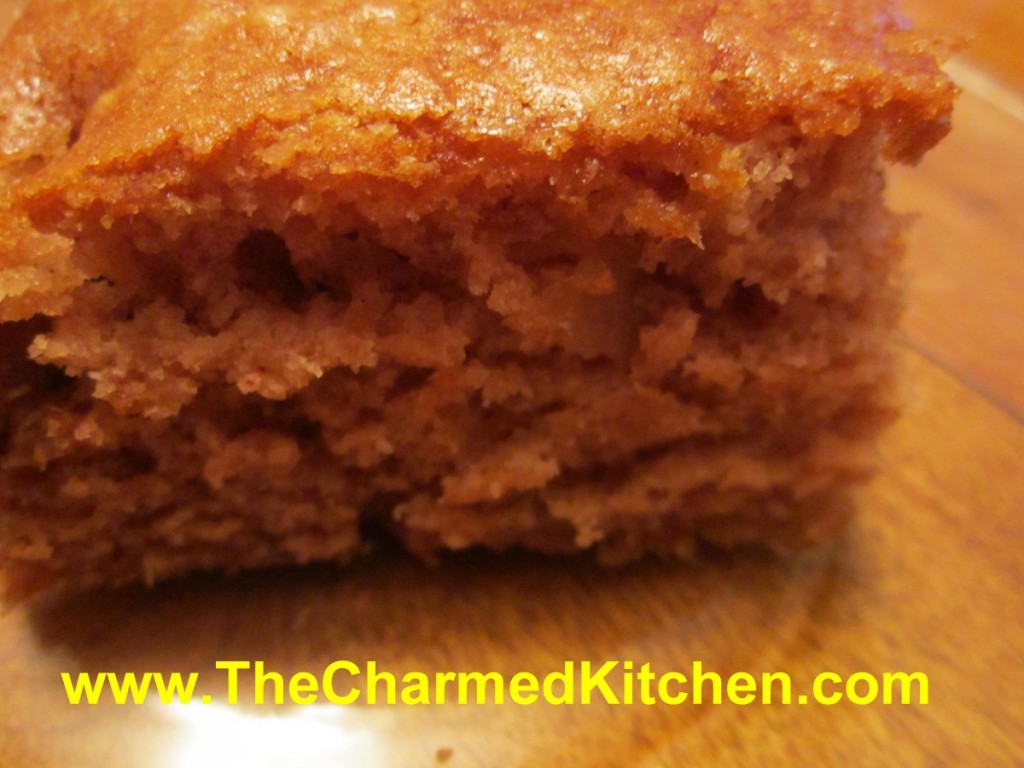
This is a favorite recipe of mine. The cake is moist, lightly spiced and very easy to make. I shared it with a friend and he really enjoyed it. The applesauce adds moisture and flavor.
I used olive oil in the recipe, which makes this cake vegan. You can make this recipe with butter instead. The spices work so well together. Sometimes simple is the best. Before someone asks, it is not a misprint, there are no eggs in the recipe. The cake rises just fine without them.
I wish I remembered where this recipe came from. I have a piece of flowered stationery, a little crinkled around the edges, creased from being folded many times, with the recipe written on it. It is not my handwriting. I would love to credit the source of this wonderful recipe.
Spiced Applesauce Cake
2 c. unsweetened applesauce
½ c. butter, coconut oil, olive oil or avocado oil
2 c. sugar
3 c. flour
1 T. baking soda
½ t. salt
1 t. each cinnamon, allspice, nutmeg and ginger
¼ t. cloves
1 c. raisins or chopped nuts, I used walnuts
Heat together applesauce and butter until butter melts. Cool down a bit. If using coconut oil, also heat up the applesauce. For other oils, just use room temperature applesauce and mix with the oil. Preheat oven 375 and grease 9×13-inch pan. Stir all ingredients together bake 30-35 minutes. Cool in pan.
Sweet Potato Pancakes
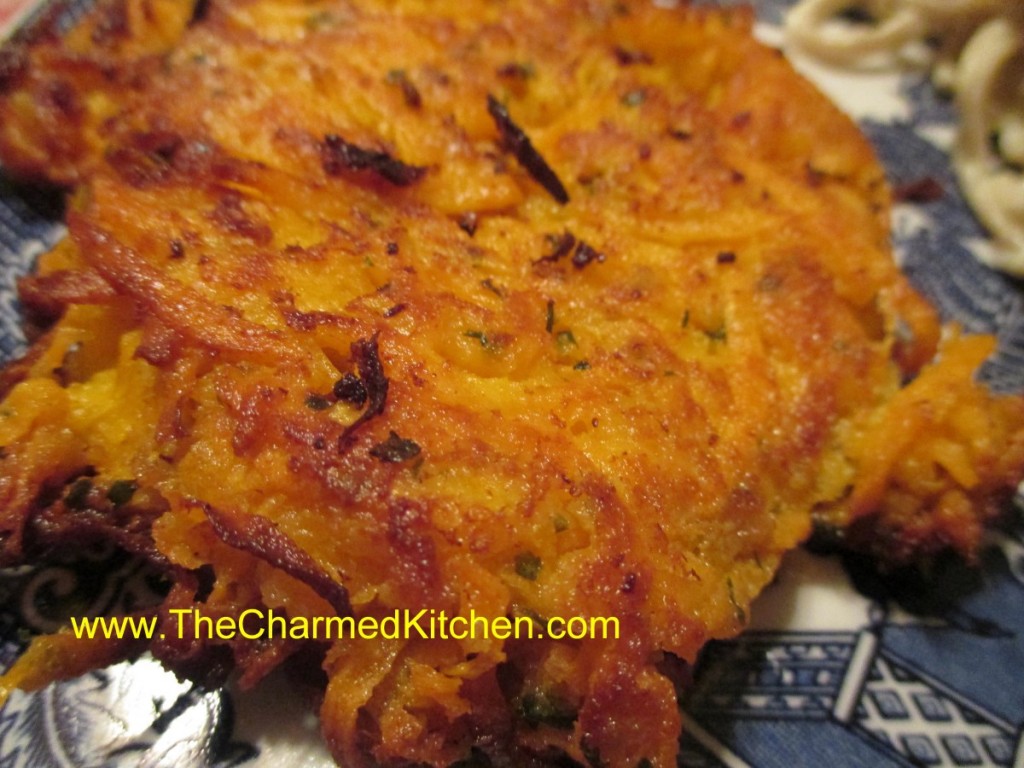
I am a big fan of sweet potatoes. They are so versatile to cook with. For me, just roasting or steaming a sweet potato, and enjoying with salt, butter and a sprinkle of nutmeg is fine. This time of year, I find myself cooking with sweet potatoes all the time.
I was looking for something different to do with sweet potatoes. I didn’t want to just roast or steam them. I ended up shredded them and making sweet potato pancakes. I had duck fat so that is what we used to fry them in.
They were amazing. Crispy on the outside and tender in the middle. I am definitely going to make them again. I could see making smaller pancakes and serving as an appetizer. Here is the recipe.
Sweet Potato Pancakes
2 small sweet potatoes, peeled and shredded- you want to end up with 3-4 cups of shredded sweet potatoes- 1 medium /large one would also work
2 eggs
½ c. panko bread crumbs
1 T. parsley flakes
1 t. hot pepper sauce, or to taste
½ t. garlic powder
½ t. onion powder
Salt and pepper to taste
Oil for frying- we used duck fat and it was wonderful
Combine all ingredients in a mixing bowl and stir until well mixed. Heat oil or fat in large skillet to 350 degrees.* Spoon batter into skillet in 4-5 pancakes, depending on the size you prefer. Cook until golden on one side- and starting to firm up- about 5 minutes. You might have to cook them in two batches – depending on the size of your pan. Don’t over crowd. They are tricky to turn over. Turn over carefully and cook at least another 5 minutes or until both sides are golden brown and crispy. Makes 4-5
* A little trick to know when your oil is hot enough. Place an un-popped kernel of popcorn in your pan with the oil when you are heating it up. Popcorn pops at 350 degrees. When the popcorn pops – it is time to add the batter.

Sweet potato pancakes cooking
Reuben Dip

Recently I was reminded about this recipe. My niece was asking about it because her husband remembered me making it for Thanksgiving some years ago. It’s funny sometimes how recipes go in and out of rotation. There is always something new to try. I am glad he asked about it. It was always a favorite and I am sure to make it during the holiday season this year.
It’s an easy recipe to put together and very tasty. Always a crowd pleaser. Corned beef, Swiss cheese, cream cheese and a few additional ingredients are combined and baked until bubbly. I did find myself making changes from the original recipe. I added horseradish and some hot sauce. I liked what both ingredients added to the dish. It can be made ahead of time and just warmed up before serving. And, of course, you can tweak it to your own preferences.
Rueben Dip
8 oz. cream cheese, chopped
½ c. sour cream
½ lb. lean corned beef, chopped
¼ c. fine chopped onions, sweet preferred
1 T. horseradish
1 T. ketchup
2 t. spicy mustard
1 t. hot sauce
1 c. chopped Swiss cheese
Mix all ingredients and place in a covered casserole dish. Bake in a 375-degree oven for 30 minutes, stirring about 15 minutes into the cooking. Uncover casserole and bake 5 minutes more. Serve warm with crackers or bread, preferably rye.
Note: You can also heat this dish up in a microwave oven for 7-10 minutes, or until bubbly. If you want it browned on the top just place under broiler (in broiler-safe dish), for a minute or 2.
Busha’s Mushroom Soup
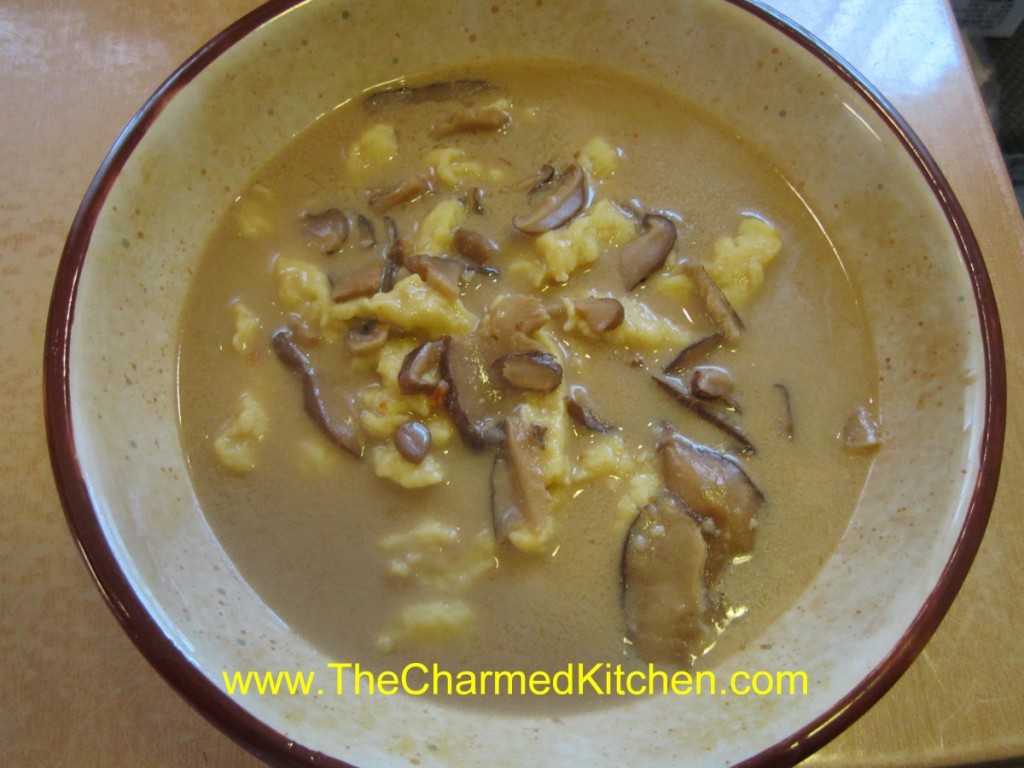
There are many variations of mushroom soup in Eastern European culture. Some have barley, others add sauerkraut. This is my family’s version. Plenty of mushrooms in rich stock, slightly thickened, and made creamy with the addition of sour cream. Ours is served with spaetzle or kluski noodles.
This soup is a tradition in my family. When I was a kid, my Busha would make it every Easter. My Mom made it for Christmas Eve. Now my niece makes it, and we have it the day before Thanksgiving.
It is one of those dishes that brings back so many wonderful childhood memories. I love the rich, earthy flavor of the mushrooms, and the slightly sweet/sour flavor of the broth. It is made with dried mushrooms, usually. I can remember watching my mom get out a big bowl and soaking the mushrooms to get them clean, and to soften them, before starting the soup.
I use dried shiitake mushrooms, but often add fresh mushrooms as well. Sometimes I use other dried mushrooms, too. I like to have a variety of mushrooms in the soup. I use chicken or beef stock. If made with vegetable stock, it could make a great meatless meal.
Busha’s Polish Mushroom Soup
4 qt. Chicken, beef or vegetable stock
5 c. dried mushrooms, about 4 0z. I use Shiitake.*
Water for soaking
½ c. flour
1 pint sour cream
¼ c. balsamic vinegar
2 T. sugar
Spaetzle or kluski noodles, cooked and drained- spaetzle recipe follows
Soak mushrooms in water for 1-2 hours. Lift mushrooms carefully out to leave any sand in the bowl of water. Rinse and drain. Set aside. Bring stock to a boil and add the mushrooms. Simmer, covered for about 1½ hours, or until mushrooms reach desired tenderness. Mushrooms will retain some “chewiness”. In medium bowl whisk sour cream into flour gradually until smooth. Stir in vinegar and sugar until smooth. Add a small amount of the hot soup to the sour cream mixture, whisking until smooth. Continue adding hot soup to the sour cream mixture until sour cream mixture is warm. Add the warm mixture to the pot of soup and stir to combine. Return to simmer and simmer 1 minute, stirring continuously. Place desired amount of kluski into bowls and ladle over the hot soup. Serves12.
Note: You can add a variety of fresh mushrooms to the soup to make it even more special. You might use portabellas; crimini, button or whatever mushrooms are at the store that day. Add in addition to the dry mushrooms; don’t reduce the amount of shiitakes.
*The dried shiitake mushrooms can be found at specialty grocery stores, some larger grocery stores and at Asian markets.
Homemade Spaetzle
3 eggs
1/2 c. half and half or evaporated milk
1/2 t. salt
1 1/2 c. flour
Combine all ingredients and let rest 30 minutes. Drop by small spoonfuls into boiling water. Cook until they float and puff up, about 5 minutes. I use a spaetzle maker, which produces smaller pieces. I only cook them a couple of minutes. Drain and serve with soups, stews, sauces or buttered.You can toss them with a little butter. I sometimes heat butter in a pan and brown them up a little. You can also add some fresh, chopped herbs to the batter.
Apple Galette
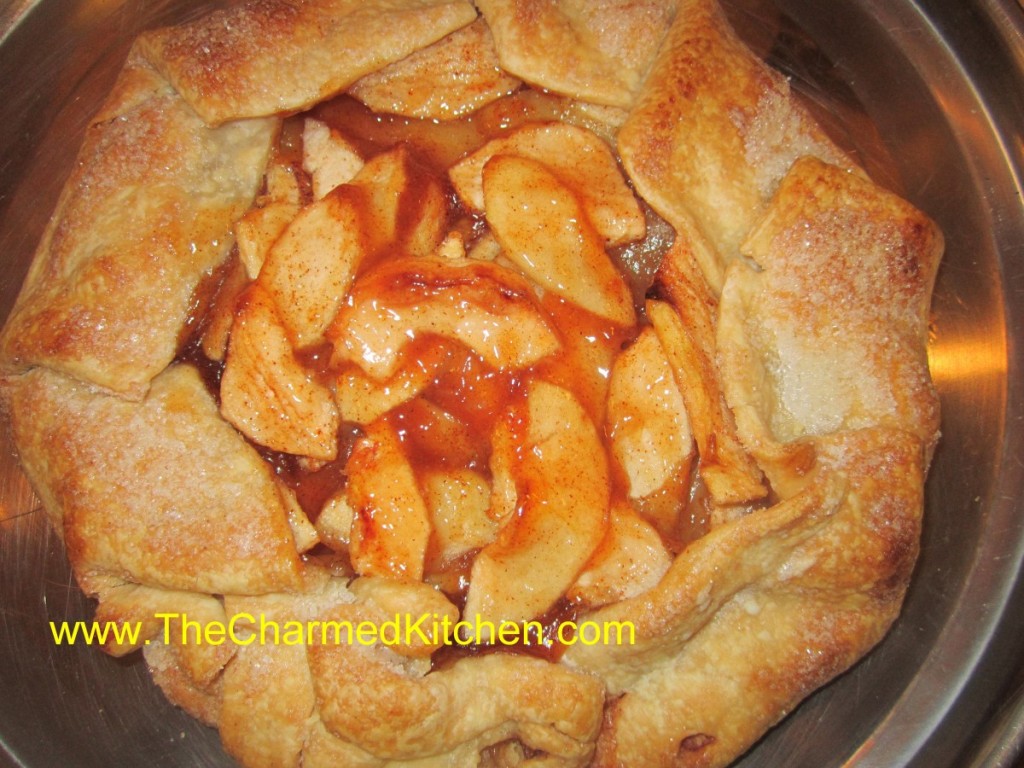
If you like apple pie, you will like apple galette. A galette is made by rolling out your crust, adding filling and folding up the edges. No pie pan involved.
I actually find a galette easier to make than pie. You don’t have to try to roll out your dough to fit into the pie pan. Nor does your dough have to be rolled into a perfect circle.
That takes a lot of pressure off, if rolling a perfect circle of dough is not your best talent. I must confess to liking its rustic charm. I make my own crust, but you can used purchased crusts, if you prefer.
You can serve your galette with ice cream, whipped cream or dusted with powdered sugar. You can make it with other fruits, as well. Any fruit pie can become a galette.
Apple Galette
Flaky Pie Crust
2 c. flour
1 t. salt
3/4 c. butter, chilled
1 T. cider vinegar
4-5 T. cold water
Combine flour and salt and cut in butter. Toss in vinegar and water 1 tablespoon at a time until dough holds together. Use a fork to toss the ingredients together and as soon as the mixture holds together stop adding water. Makes 2. Chill well before using.
Filling:
5-6 medium apples- I used Jonathan, Gala and Macintosh
2/3 c. sugar- plus extra for sprinkling
3 T. cornstarch
1 T. cinnamon
1 T. Lemon juice, plus extra for treating the apples
1 t. nutmeg
1 t. vanilla
1/2 t. salt
Prepare dough. Roll half the dough into a 10-inch circle- repeat with remaining dough. Keep covered with plastic wrap until ready to use. Peel and core apples and slice thin. Place apples in water with lemon juice added to prevent browning. Drain apple slices well and place in a bowl. Toss with the sugar, cornstarch, lemon juice and seasonings. Place one of the crusts on a baking sheet. Pile half of the prepared apples on the center of the crust. You should have about a 2-inch circle of dough around the edges that is uncovered. Fold edges of the crust up over the apples pressing lightly to hold in place. Sprinkle with a little extra sugar. Repeat with the remaining crust and apples. You will have a little liquid in the bowl from the apple mixture- save that for now. Place the galettes in a preheated 425 degree oven and bake for 15 minutes. Turn down heat to 350 and bake for another 40 minutes or until crust is golden brown. While galettes are baking take the liquid left from the apples and cook in a small saucepan until thickened- it will take a minute or two. This will be used to glaze the galettes. When galettes come out of the oven brush the apples with the thickened glaze. Cool on wire rack. Makes 2.
New Day Cleveland – Spice Mix
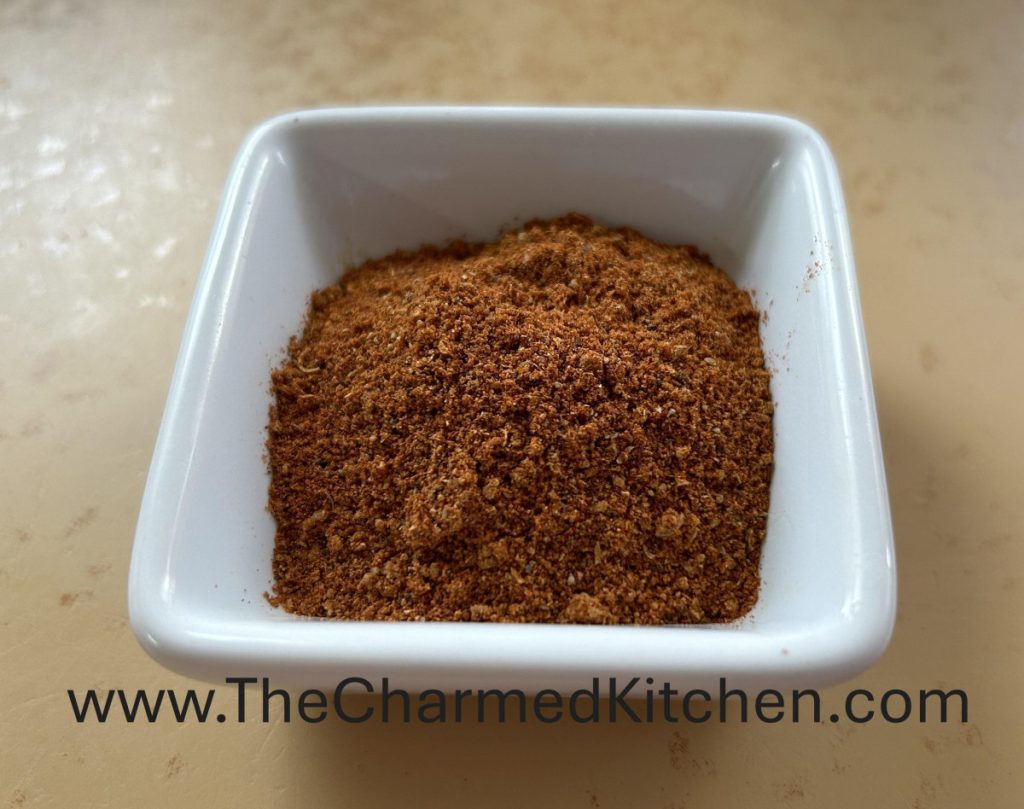
It was so much fun to cook on New Day Cleveland yesterday. As always, the whole crew was warm and welcoming. Here is my spot with some recipes, too.
https://fox8.com/on-air/new-day-cleveland/cooking-classes-for-fall
Savory Autumn Spice Blend
1 T. paprika
2 t. ground coriander
2 t. mace
1 t. cinnamon
1 t. ground cumin
1 t. ginger
1 t. black pepper
Combine all ingredients and store in an airtight container in a cool place. Use on meats, in dips, soups, stews and marinades. Toss with veggies before roasting or add to butter and spread on bread or add to hot vegetables.
Note: For a larger batch of the spice blend combine:
3 T. paprika
2 T. ground coriander
2 T. mace
1 T. cinnamon
1 T. ground cumin
1 T. ginger
1 T. black pepper
Autumn Red Sauce
2 T. oil
1 T. butter
1 medium onion, peeled and chopped
3-4 cloves garlic, minced
1-2 T. Savory Autumn Spice Blend
2 c. tomato sauce
In saucepan cook onions in oil and butter, over medium heat, until tender. You can brown them a little, if you like. Add the spices and garlic and cook 2-3 minutes. Do not let garlic burn. Add the tomato sauce and heat to a simmer. Simmer over low heat for 15 minutes, stirring occasionally, to prevent burning. Add salt if needed. Makes 2 cups.
Autumn Spice Roasted Potatoes
4 lb. potatoes, scrubbed and cut in chunks
1/4 c. olive oil (amount can be reduced)
2 T. savory Autumn Spice blend
salt and pepper to taste
Place potatoes on baking sheet and toss with the oil. Sprinkle with the seasonings and stir to coat evenly. Bake in a 400 degree oven for about 1 hour or until tender, but browned. Type of potato will affect baking times as well as the size of the pieces. Serve with sour cream. Serves 6-8.
Autumn Dip for Veggies
1 (16 oz.) carton of sour cream- you could use Greek yogurt
2-3 teaspoons of the Savory spice Blend
1 t. salt
2 green onions. Trimmed and chopped
Hot sauce to taste
Combine all ingredients and chill until ready to use. Great with veggie tray or on baked potatoes.
Easy Apple Fritters
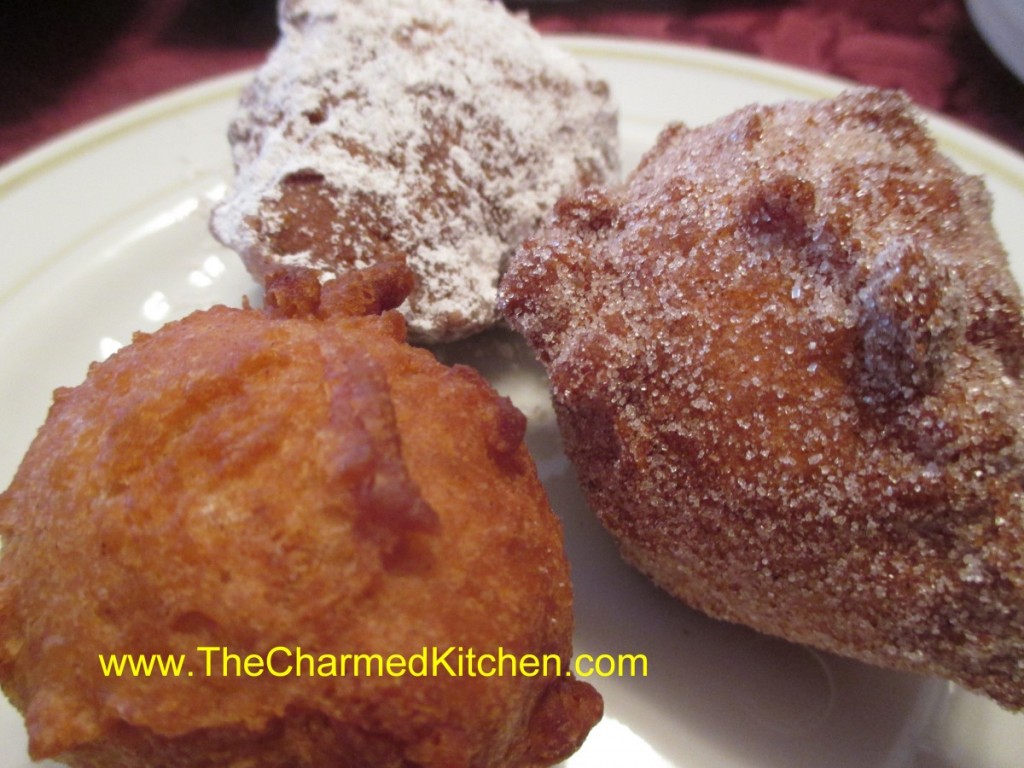
I love apple season. Besides eating them fresh, I enjoy cooking with apples. One of my favorite apple dishes is apple fritters.
Fritters are similar to doughnuts. Rather than being made from a dough that is rolled and cut, like doughnuts, fritters are made from a batter. The fritter batter is spooned into oil for frying. They are actually very easy to make.
Good fritters are light and airy inside, with a crisp outside. These are very good fritters. These fritters have diced apples and cinnamon in the batter and cook up tender and light. Fritters are good plain, but can be rolled in powdered sugar, cinnamon sugar or drizzled with a powdered sugar glaze. Unlike a lot of the giant-sized fritters I see at local orchards and farm markets this time of year, these fritters are smaller. Only a few bites each. I actually prefer that.
For my gluten-free friends, I have made these fritters with gluten free flour. They tasted great. The gluten free version seemed to brown faster, so I turned down the temperature of the oil to 350 degrees.
So enjoy one of my favorite recipes of the season, and make yourself some fritters.
Apple Fritters
2 c. flour
2 T. sugar
2 T. baking powder
1 T. cinnamon
1/2 t. salt
1 c. milk
2 eggs, beaten
2 T. melted butter
1 c. diced apples
oil for frying
Combine dry ingredients and set aside. Mix together milk with the eggs and butter. Stir in dry ingredients until just moistened and add the apples. Heat oil to 375. If using gluten-free flour heat oil to 350. Drop dough by tablespoonfuls into the hot oil and fry until golden brown. Don’t do more than 4-5 at a time. It will take about 4 minutes in total but you need to turn them to brown evenly so 2 minutes per side. Drain on paper towels. While warm roll in powdered sugar, cinnamon sugar, or drizzle with a powdered sugar glaze. Makes about 32.
Savory Spiced City Chicken
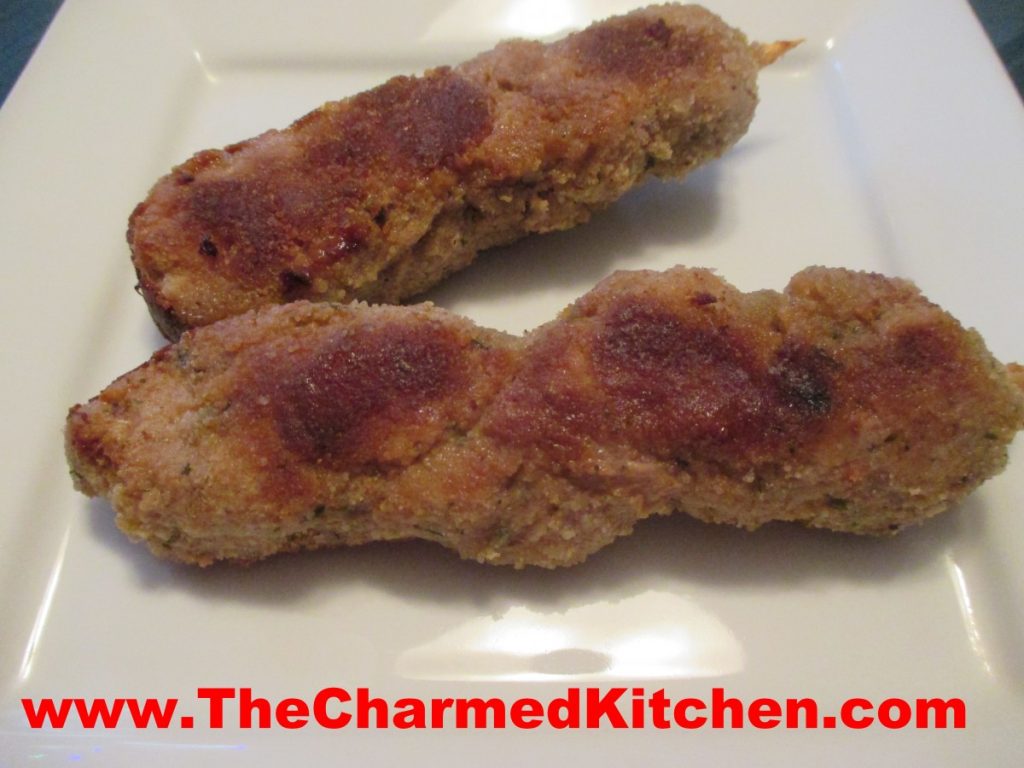
If you never had City Chicken, you don’t know what you are missing. Meat on a stick- always a good thing. But not just meat on a stick- breaded meat on a stick! If you like breaded pork chops, you should love City Chicken. This is a dish I grew up with. When my Mom made City Chicken, I knew dinner was going to be special.
There is no chicken in the dish at all. Odd, but well, I didn’t name the dish, I just like eating it.
City Chicken is normally made with chunks of pork- or chunks of pork and veal- skewered on wooden sticks. I used pork. After skewering, the meat is dipped in seasoned flour, egg wash and then bread crumbs- or cracker crumbs. You can just bake them, or brown in a little oil first, before baking- for a crispier coating. They also can be cooked in an air fryer or convection oven.
My friend Joe and I were talking about how to make it more seasonal. He suggested using different spices. I ended up creating a seasoning blend of some of the warm spices I think of when I think about fall. Here is my latest version of City Chicken, with the new spice blend recipe included.
Savory Spiced City Chicken
2 lbs. boneless pork – I used Western style ribs
½ c. sherry – not cooking sherry
2 T. soy sauce
¾ c. flour
Salt and pepper
3 eggs
½ c. milk or half and half
1-2 T. Savory Autumn Spice Blend, recipe follows
1-2 c. bread crumbs
Oil
6 –inch Wooden sticks or skewers
Cube pork into 1-inch cubes. Place in a bowl and add the sherry and soy sauce. Stir to combine, cover bowl and place in fridge. You can do this a couple of hours ahead or even a day ahead. You might not really need to do this step, but I like the flavor of the sherry, so I chose to marinade my pork in it before breading. Your choice, completely.
Take pork and skewer it onto wooden sticks. I ended up with 9.
Place flour in a bag with salt and pepper to taste. Add one pork skewer at a time to the flour, shaking to coat evenly. Place floured pork skewers on a tray. Once finished, combine eggs with the milk, savory herb blend and a little more salt and pepper. Pour egg mixture into a shallow dish, long enough to hold the skewers. Place bread crumbs in a bag and set aside. Dip each floured skewer into the egg mixture, remove from egg mix and allow excess to drip off a little. Then place in the bag of bread crumbs, shaking to coat evenly. Repeat until all the city chicken is breaded.
Now I know I already asked you to wait to marinade the pork in the beginning. I am going to ask you to wait again. If you fry up the city chicken right away, the breading is likely to fall off. If you bread the city chicken early in the day- then leave it in the fridge at least a couple of hours before cooking it, the breading will stay on much better. I actually marinade a day ahead, in the morning. Then I bread them in the evening the night before. But even breading them a couple of hours before makes a big difference. Just keep in the fridge until you are ready to cook.
When ready to cook them- I know you were giving up hope we would ever get to this step- heat oil in a large skillet. You don’t need much oil- a few tablespoons, at most. Brown the city chicken on all sides in the hot oil. Transfer them to a baking dish, as you finish browning them. Place in a preheated 350-degree oven for about 30 minutes. Don’t bake them too long- you don’t want them to dry out. Pork has to reach a minimum internal temp of 145 F. Serves 6.
Savory Autumn Spice Blend
1 T. paprika
2 t. ground coriander
2 t. mace
1 t. cinnamon
1 t. ground cumin
1 t. ginger
1 t. black pepper
Combine all ingredients and store in an airtight container in a cool place. Use on meats, in dips, soups, stews and marinades. Toss with veggies before roasting or add to butter and spread on bread or add to hot vegetables.
Note: For a larger batch of the spice blend combine:
3 T. paprika
2 T. ground coriander
2 T. mace
1 T. cinnamon
1 T. ground cumin
1 T. ginger
1 T. black pepper
Pineapple Jelly
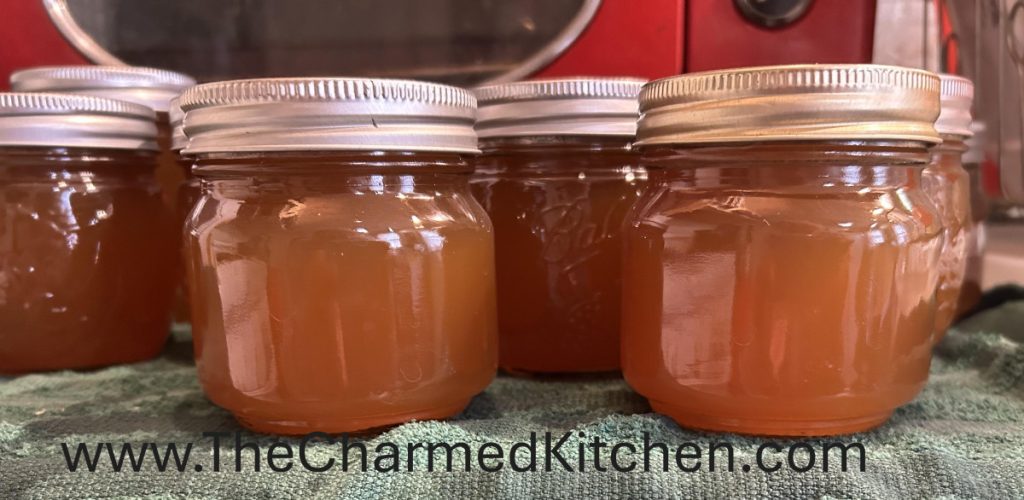
I had a bottle of pineapple juice that I bought for some reason, then never used. I decided to do something with it. I looked around and found a few recipes for making jelly from the juice. That seemed like a great idea, so that is what I did. I was very happy with how it came out. From a 64 ounce bottle I got 2 batches of jelly and ended up with 13 jars in total. I got just over 6 jars in one batch. So here is how I made it. I think it will make nice gifts for the holidays.
Pineapple Jelly
4 c. pineapple juice
½ c. lemon juice
1 (1.75 oz.) box powdered pectin- or 6 Tablespoons pectin
5 c. sugar
Start water simmering in water bath canner. Water should be deep enough to cover jars with at least an inch or two of water. Wash 6 jelly jars and lids. Fill jars with hot water, set aside. Place lids in hot water and set aside. In large pot combine the juices and pectin. Stir until combined and bring to a boil over high heat. Once mixture reaches a boil that cannot be stirred down, boil 1 minute. Add the sugar, stir in and return to the boil. Once the jelly starts boiling hard, boil for a minute longer. Remove from heat and skim off any foam. Drain the jars of the warm water. Ladle hot jelly into jars, leaving ½-inch headspace. Wipe rims with a damp paper towel and screw on the lids. Lids should be fingertip tight. Repeat with remaining jars and lids. Place jars in the canner. Cover the pot and when the water returns to the boil, start timing. Process for 10 minutes. Turn off heat and leave jars in the canner 5-10 minutes more. Remove jars to a draft free counter on a towel or cooling rack and allow to cool down. Check the lids the next day. Makes about 6 jars.



